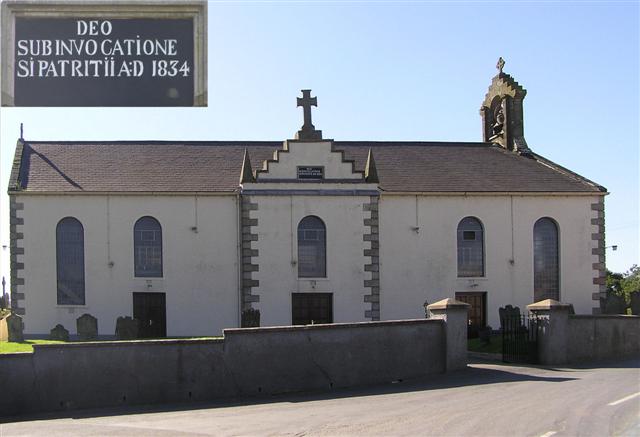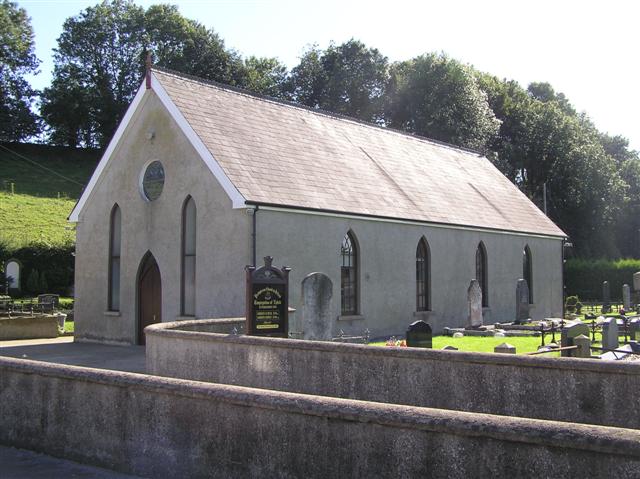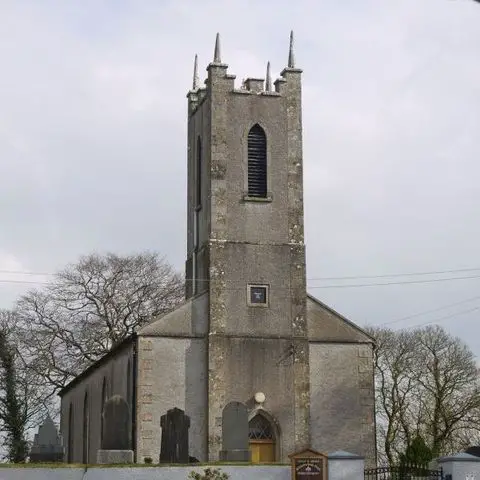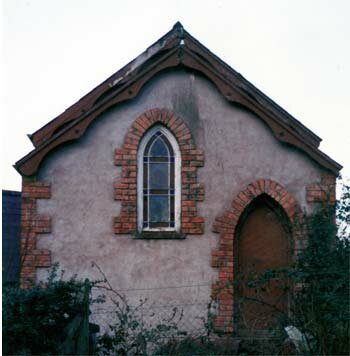Churches of Eglish
St. Patrick’s – Eglish

The present church of Saint Patrick at Roan is built on a remarkable oval-shaped mound surrounded by a strong retaining wall which varies in height to suit the topography of the surrounding ground. The present church was built in 1834 and is said to be the third built on the site. Given the discovery of an early cross base at Roan it is certain that a monastic site was located here in the 7th Century or earlier. 12th Century carved stones are also associated with the site, so it is probable that the second church was built then. It is possible that Roan was a centre of worship even in pre-Christian times.
St Patrick’s Church – Knocknacloy

The churches at Eglish and Knocknacloy were originally part of the parish of Clonfeacle (also an early monastic site) and the church site there bears a remarkable resemblance to Saint Patrick’s at Eglish.
It is uncertain whether the church at Roan was the original church of the present parish as there was also a very early church in the townland of Knocknacloy. The only church in the parish shown on the 1609 Baronial plantation map is at Knocknacloy and as may be seen from the map it was roofless. It is clear also that the district we now call Eglish was known as “Cosh Oon” while Knocknacloy was shown as “Knockloh”. An inquisition of 18 June 1636 found that the “ecclesiastical land” ac villa de Cnockclogh (“and farm of Cnockclogh”) measured 2 balliboes. One of the last remaining landmarks of this site is a well, which is still known as St. Patrick’s.
Presbyterian Church – Eglish

The church called Derryfubble was in existence by 1769, for in that year they attempted to call Mr William Henry, but the Presbytery refused to sanction the call. Eventually Derryfubble secured the services of Mr David Holmes as their minister. Mr Holmes was also in charge of Ballymagrane and lived in the Dyan area, midway between the two churches.
Rev. Holmes seems to have influenced the people and by 1800 a new church was built in Eglish. Rev. Holmes was an earnest and evangelical preacher; eventually he became unwell and retired in 1802, dying in 1812. At the time of his resignation in 1802, Eglish became a separate charge.
In 1803, Eglish obtained the services of Hugh Bell as a minister; he was ordained on the 23rd December. Mr Bell was a faithful minister of the Gospel. He was known for his quick wit and quaint remarks sometimes lacking in dignity, using the ordinary events of every day life for illustration.
St. Columba, Church of Ireland – Derrygortreavy

A commencement was made in 1813 to build the new Derrygortreavy church, when the site, which is but a short distance North-west (one mile) from the ancient church site, was obtained from the then Lord Northland, the “owner” of the soil. The church, described as a small neat edifice with a lofty square tower, was erected in 1815 at a cost of £800, which was contributed by the Board of First Fruits. The next step was the erection of a residence for the clergyman, and in 1820 a fee farm grant of glebe lands was obtained in the townland of Drumnashalogue (“the ridge of the hunt”) from the Evans family. This glebe house was built in 1822 at a cost of £500, contributed by the board of first Fruits, with only £50 of the amount being repayable. The Evans family were largely responsible for the plans and design, as their relative, the Rev. George Evans was the first occupant. However, it was not until the building was approaching completion that it was found that the necessity for a staircase had been forgotten. The result was that a covered stairway had to be erected outside the building, but this has been somewhat modified. The glebe house has always been called Greystone Rectory, and the signpost which had been near the church had “Greystone” on one of its arms, but any wayfarer who looks for a village of that name or house of refreshment will be disappointed. There is a post-office which is now closed, and a new bungalow where our organist Christine Devlin lives.
A parochial school was built beside the church in 1825 and was aided by an annual donation from Lord Ranfurly. It is now occupied by the local Orange Society, and used by the church as a parochial hall, but there were until recently several good elementary schools within the bounds of the parish. The church bell was placed in the tower in 1833 and still calls the faithful to worship every Sunday. It was subsequently found that some townlands in the north-east corner of the parish were awkwardly situated for parochial purposes, and so in 1920, Moygashel, Mullaghanagh, and Mullaghadrolly were separated from Derrygortreavy and added to the adjoining Parish of Drumglass (Dungannon).
The Early Beginnings – Gortmerron Church

On the 18th March, 1894 the Derrycreevy Church (later known as Gortmerron) was formed, an event that would have a significant impact on the lives of many ordinary people. The Church was initially formed as “Derrycreevy Baptist Church”. The first recorded minutes of a Church meeting are dated 1898, four years after its formation. The entry is brief and mainly financial in nature. The minutes do, however, record that “the name of the Church has been changed from Derrycreevy to Gortmerron”. The minutes also give details of monies raised towards the renovation and conversion of a store into a hall for the Church to meet in, at a cost of £78.10s.0d.
From its early days the Church has been associated with the Baptist Union of Ireland (now known as The Association of Baptist Churches in Ireland). The Union handbook carries the following entry for 1899/1900: “Gortmerron” the sum of £25.4s.6d was raised towards the reduction of building debt, the small sum of £7 being all that now remains. The handbook also lists James Rainey, Gortmerron, Brantry, Dungannon as Pastor and Alex Pringle, Bolton’s Walls, Caledon as Church Secretary. Sunday Service times are given as 12 noon and 5 p.m. The Church minute-book carries the report to the Union for 1902:
At our annual Church meeting we were reluctantly compelled to remove three names from the roll. And we regret to say another by transfer to a sister Church in Dublin. We can ill afford to lose these members … Although one has been baptized during the year … none [has been] added [to the roll]. Yet prospects are as bright as the Promises of God, several giving the clearest evidence of a change of heart. Sabbath School [is] feeble. The little band of twelve [members] having contributed to all purposes almost £40.0s.0d. One thing is needed, a baptistery. Who will help?
The 1903 Union Report speaks of blessings at Gortmerron: “After years of sowing we have begun to reap …” The 1904 Union Report tells of additions in membership:
Gortmerron “While we are thankful for an increase of ten during the year” one by transfer and nine by baptism we record with sorrow the loss of one of our most active members by death, our dear brother M’Gahey. May his homecall nerve us to more active service.
📎 Related Articles
1. History of Churches in Northern Ireland
2. Manchester’s Historic Seaside No. 1 Firehouse
3. Trask House: Preserving History in Every Corner
4. The Riveting Timeline of Manchester-by-the-Sea
5. Exploring the Historical Threads of Manchester-by-the-Sea
